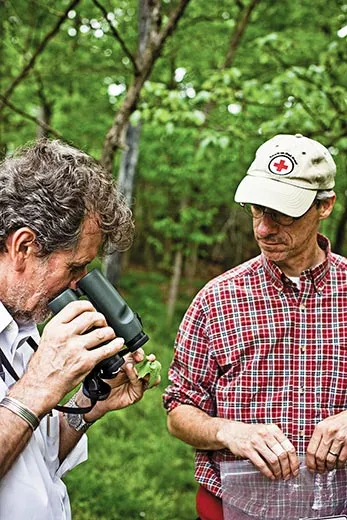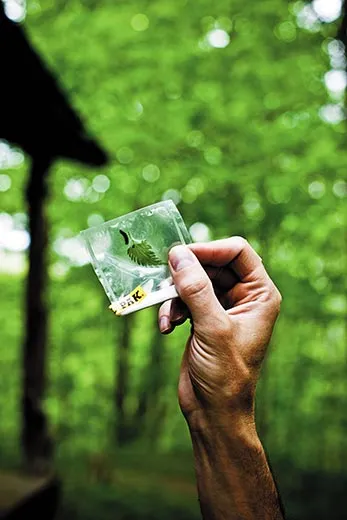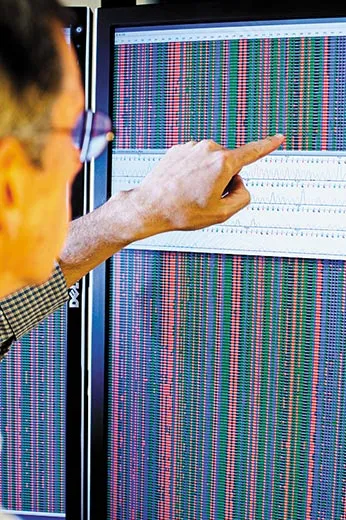Cracking the DNA Code
On a small island near Washington, D.C., Smithsonian researchers have found a genetic code that could revolutionize botany
/https://tf-cmsv2-smithsonianmag-media.s3.amazonaws.com/filer/Dave-Erickson-barcode-plant-species-Plummers-Island-631.jpg)
The expedition team didn't expect the water to be so high or the final stretch of the planned route across a narrow channel impassable. The scientists have to scramble across a crude bridge of downed branches to get to the island's southeastern tip and begin collecting specimens.
"Essentially, we're standing in a tropical forest," says botanist John Kress. In the muggy heat, he's rolled up the sleeves of his white dress shirt. He grabs a small tree branch and brings its burgundy flowers into closer view. "I feel like I'm in Costa Rica," he says.
A high-pitched whistle emerges from the forest. Kress' colleague, botanist Dave Erickson, jokingly asks if it's a howler monkey, which lives in Central and South America.
"It's whatever you want it to be," says Kress.
Plummers Island, a 12-acre, teardrop-shaped landmass in the Potomac River—just over ten miles from Kress' office at the Smithsonian National Museum of Natural History—is about as unspoiled, and unlikely, a landscape as can be found inside the Washington, D.C. Beltway. Owned by the National Park Service since 1961, Plummers is also the most thoroughly studied island in North America. And, thanks to Kress and his colleagues, it is the first site in the world to have all 250 of its plant species barcoded.
DNA barcoding, the brainchild of Canadian geneticist Paul Hebert, is modeled after the Universal Product Code (UPC) found on consumer packaging. Each UPC has a number designating the manufacturer (say, a soft drink company) and a specific product identifier (diet, caffeine-free, etc.). Hebert found a segment of animal DNA common to all species (the manufacturing code) and varied enough to distinguish among animal species (the product identifier). But researchers have had a harder time finding a standardized DNA segment for plant life.
Starting five years ago, Kress' research team collected samples of every plant species on Plummers Island. Then, in a botany lab, Erickson and others determined each one's DNA sequence. From there, they homed in on three genetic zones—two genes and an "intergenic spacer" between genes—that collectively could distinguish the plants. Along with other botanists, Kress and Erickson are in the midst of a formal process to get the markers approved as the standard plant barcode. Kress is hoping for official acceptance within a year from the Consortium for the Barcode of Life, a project established in 2004 to compile a reference library of codes.
Until recently, taxonomists needed a plant's flowers or fruits to classify it, meaning they had to collect samples at specific times of the year. But with DNA barcoding, they can use any part of the plant—seeds, bark, roots or leaves—to identify it.
"But the biggest benefit is that you won't have to be an expert," says Kress. In the not-so-distant future, even schoolchildren will be able to identify plants with hand-held DNA sequencers. They could then upload the barcodes via smartphones to an online encyclopedia with basics about the species, botanical art and anecdotal information. The Food and Drug Administration could use barcoding to test herbal supplements; U.S. Customs and Border Protection could use it to identify suspicious imports.
Erickson has also found plant DNA in the ground-up guts of ten different orders of insects from Plummers Island. He wants to better understand which insects are specialists, meaning they eat certain plant species, and which are generalists, which eat just about anything.
"I'm a find 'em and grind 'em kind of guy," says Erickson, turning a common botanical slur into a boast. Kress, a vegetarian, rolls his eyes in feigned disgust.
"You're definitely not a specialist," Erickson teases, dropping a bright green caterpillar into a tiny specimen bag. "You're a generalist. I've seen you eat."
/https://tf-cmsv2-smithsonianmag-media.s3.amazonaws.com/accounts/headshot/megan.png)



/https://tf-cmsv2-smithsonianmag-media.s3.amazonaws.com/accounts/headshot/megan.png)